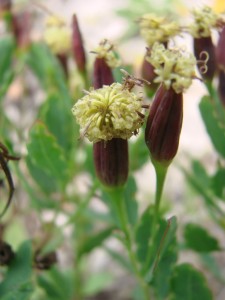
Papalo flowers
Papalo, Porophyllum ruderale, is native to South and Central America and the American Southwest. It grows as a weed, but has a long history of use in the local cuisine, stretching back as far as the Aztecs. It was probably used before that, but the indigenous population had no recorded history. The invading Spaniards were the first to record its use.
The name comes from the Nahuatl, a native language, and is the word for butterfly, papalotl. The Spaniards called it mampuitu, which means skunk because of the pungent odor when many plants are growing together. Thanks to its popularity with the Quechua people of Bolivia, it’s also called Bolivian Coriander even though it is no relation to coriander, Coriandrum sativum.
Papalo is an annual plant that does best in full sun, although it can tolerate some shade, and likes well-drained soil. The soil should be allowed to dry out between waterings. It grows 5 to 6 feet tall with purple starburst flowers. The flavor has been described as similar to arugula, cilantro and rue. It is said to be an acquired taste.
Papalo leaves are used raw or added to dishes at the end of cooking because it loses its flavor if cooked. It also does not retain its flavor when dried. It is often used in place of cilantro in recipes because it is available all summer due to its tolerance for heat. Cilantro bolts when temperatures consistently reach 70⁰F so it is only available in the cool spring and fall weather.
Because of its strong flavor, when using papalo in place of cilantro, use only ½ to ⅓ the amount called for in your recipe. Leaves should be harvested when they are young for a milder flavor. Older leaves have more of the oil that gives it its distinctive taste. The strong odor of the oil functions as an insect repellent for the plant.
Like most native “weeds”, papalo is easy to grow. You can start your seeds indoors 4 to 6 weeks before your last frost. It has a poor germination rate so be sure to plant more seeds than you think that you need. You only really need 1 or 2 plants because of their large size to get a full season of tasty leaves. Seeds should be planted ½ inch deep. Germination will occur within 10 to 20 days. You can transplant your seedlings into your garden after your last frost when they are at least 2 to 3 inches tall. You can also direct sow the seed in your garden after all danger of frost.

